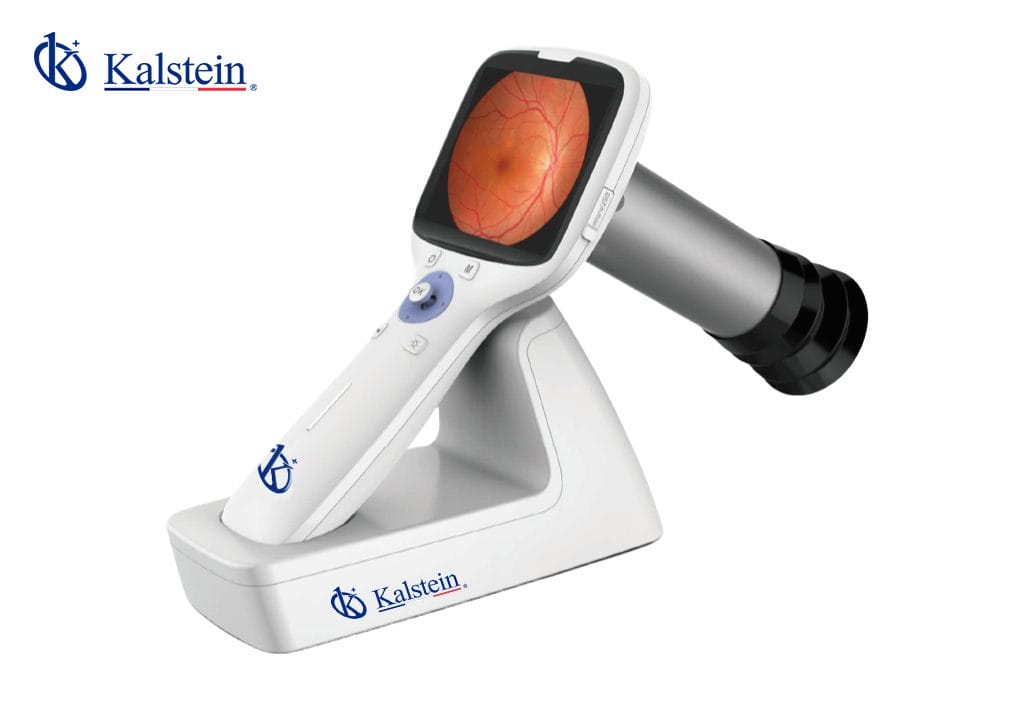Fundus cameras for veterinary use have become essential tools for diagnosing eye diseases in animals. As a veterinary professional, I have worked with various brands and models, and I can confidently say that a good fundus camera is key to early detection of critical conditions such as retinal detachment or corneal ulcers.
The cameras I have used include both portable and desktop options, offering different features for various clinical needs. However, I always look for equipment that is easy to use and provides high-quality images, like those offered by Kalstein.
Features of the Veterinary Fundus Camera
One of the main features I look for in a fundus camera is its ability to operate without pupil dilation (non-mydriatic), which reduces the procedure time and stress for the animal. I also value a wide field of view, such as that offered by Kalstein’s portable cameras, which provide a 50° viewing angle, ideal for capturing detailed images of the retina in a single shot.
Another essential feature is the ability to capture images of both the posterior and anterior segments of the eye, enabling a more comprehensive diagnosis. Cameras like the one from Kalstein, which I have used on multiple occasions, offer this functionality along with silent operation and specific lighting modes for fluorescent images, ideal for monitoring corneal abrasions.
Why is the Veterinary Fundus Camera Priced This Way?
The price of a fundus camera can vary depending on its features and capabilities. I have observed that Kalstein cameras, despite their advanced technology, maintain an excellent price-quality ratio compared to other products on the market.
Additionally, their durability and the possibility of upgrading modules fully justify the investment. You are not only paying for the camera but also for reliability and technical support, which is crucial in a clinical setting.
Compare Veterinary Fundus Cameras with Similar Products
When comparing Kalstein cameras with other options on the market, such as those from Optomed and Eickemeyer, I have noticed several advantages. For example, Optomed cameras, like the Smartscope PRO, offer excellent portability and are highly functional for eye examinations in a variety of animal species.
However, Kalstein cameras stand out for their more ergonomic design and ease of use during prolonged procedures, as well as generally more competitive pricing.
Pros and Cons of Veterinary Fundus Cameras
|
Pros |
Cons |
|
Non-mydriatic operation |
May require initial training |
|
High image quality |
Initial cost can be high |
|
Portable and lightweight design |
Accessories can be expensive |
|
Versatility in anterior and posterior segment imaging |
Requires regular maintenance |
|
Compatible with advanced software |
|
|
Easy integration with medical reference systems |
|
|
Silent operation, ideal for clinical environments with nervous animals |
|
|
Modular upgrades available |
Advantages of These Veterinary Fundus Cameras
One of the main advantages I have experienced with Kalstein fundus cameras is their ease of integration into daily clinical routines.
The ability to capture detailed images without the need to dilate the animal’s eyes significantly reduces procedure time. Additionally, the image quality allows for more accurate diagnoses and easy sharing of results with specialists or external laboratories.
Other Benefits of These Veterinary Fundus Cameras
Another key benefit is the durability of this equipment. Kalstein cameras are designed to withstand heavy use in veterinary clinics, where frequent handling and variable conditions can affect less robust equipment.
Moreover, their modular design allows for the upgrading of specific components without needing to replace the entire system, which is a great advantage in terms of long-term cost.
Reviews on Veterinary Fundus Cameras
The reviews from other veterinary colleagues confirm my experience. Kalstein cameras are valued for their reliability and ease of use. Veterinarians who have used models like Optomed’s Aurora IQ also highlight its portability and ability to capture detailed images without the need for dilation, but they often mention that they prefer Kalstein’s more comprehensive solutions for a broader range of procedures.
Frequently Asked Questions
Do these cameras require pupil dilation?
No, Kalstein cameras operate without the need for dilation, which reduces procedure time and animal stress.
Are they easy to use?
Yes, their intuitive design allows veterinarians and technicians to use them with minimal training.
What is the average cost?
The cost varies depending on the model and additional functionalities, but Kalstein cameras offer excellent value for money compared to other brands like Optomed.
What types of animals can be examined?
These cameras are versatile and can be used on a variety of animals, from small pets to livestock and zoo animals.
Can the cameras be upgraded?
Yes, Kalstein offers upgrade modules that enhance the cameras’ capabilities without needing to purchase new equipment.
Do they offer technical support?
Kalstein provides comprehensive technical support for their products, ensuring any issues are resolved quickly to minimize interruptions in the clinic.
Conclusions on These Veterinary Fundus Cameras
In summary, Kalstein fundus cameras are a reliable and efficient solution for visual diagnostics in veterinary care.
Compared to other brands on the market, they offer an excellent combination of image quality, ease of use, and durability, making them a smart investment for any veterinary clinic.
Are you looking for superior quality medical equipment, ready to boost your lab’s efficiency? Visit https://kalstein.us/category-product/veterinary-sector/veterinary-fundus-camera/ to explore our high-end catalog filled with the best finds at the most competitive prices. Excellence is our hallmark; we innovate and manufacture high-precision equipment that is both reliable and durable to meet your needs. Why wait? Make your purchase online quickly and safely, and leap into the future of medical technology today. https://kalstein.us/

